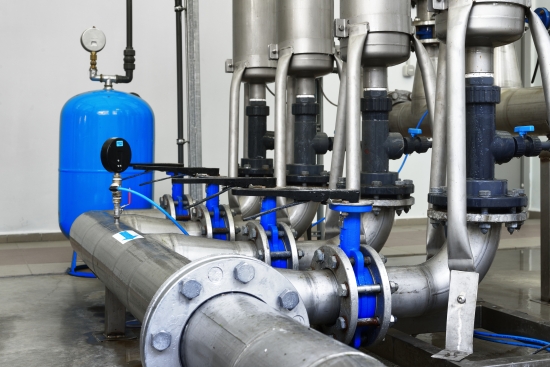
Compressed air is critical, from manufacturing, automotive assembly, and food and beverage production to health care facilities, dry rooms, industrial systems and various other industrial and commercial applications. Commonly referred to as the “fourth utility,” compressed air is an essential component across different industrial processes, impacting the quality of the process and the end product.
However, the cost of clean, dry compressed air is extremely high — about eight times more expensive than electricity — since compressing air requires a significant amount of energy, most of which disperses as heat. Consequently, accurate compressed air measurement is crucial because carefully managing and monitoring compressed air allows operators to monitor and control the efficiency of compressed air systems.
Dew Point and Compressed Air Measurement
Inaccurate or inconsistent compressed air measurement can result in decreased system performance, increased energy costs, equipment damage and even safety hazards. For example, the equipment can malfunction or fail if the pressure is too low, leading to downtime and costly repairs. If the dew point is too high, condensation and moisture can build up in the system, leading to corrosion, contamination, freezing and reduced air quality.
Dew point is one of the most important parameters associated with the quality of compressed air because moisture in compressed air can cause corrosion, equipment damage and contamination, and negatively impact the performance of pneumatic tools and systems. In compressed air systems, the dew point is a measure of the temperature at which moisture will begin to condense out of the air and into dew or frost, leading to potential problems. Accurate dew point measurements help avoid over-drying, optimize energy usage and protect equipment from adverse impacts.
To reveal energy-saving opportunities, bring excessively high costs down and optimize the performance and lifespan of compressed air systems, decision-makers across industries must manage and monitor their compressed air systems with dew point measurement solutions.
Exploring the various factors that impact the accuracy of dew point measurements is vital considering their implications on the performance and efficiency of compressed air systems. Understanding how each factor influences measurement precision is crucial to optimize operations and boost the bottom line.
Factors Impacting Compressed Air Dew Point Temperature
Recognizing that high-quality compressed air is essential to production and products, decision-makers across industries are installing dew point sensors and monitors to better detect any issues with their compressed air systems. Because several factors can impact the accuracy of dew point measurement in compressed air systems, considering these factors when selecting dew point measurement equipment and interpreting the results of measurements is essential.
Temperature
Even dew point temperature as a parameter is not dependent on temperature. Usually, instruments measuring dew point need accurate temperature information, and depending on structures, measurement can be sensitive to the temperature of the gas or ambient temperature.
Some advanced dew point measurement solutions can compensate for ambient and gas temperature variations, improving the accuracy of the measurements. Since dew point temperatures in compressed air range from ambient to -80°C (-112°F), select stable and consistent solutions that reliably deliver accurate measurements across the necessary scope.
Pressure
Depending on the temperature, air can only hold so much water vapor, with the maximum amount referred to as water vapor saturation pressure. Air compression increases water vapor pressure — and the dew point. If not correctly compensated, this could affect measurement accuracy.
Knowing whether pressurized dew point measurement is conducted or not is a key consideration. Depending on the system design and target specification, the ambient dew point of gas or process pressure dew point of gas needs to be converted if necessary for comparison to each other or system specifications. In addition, measuring in a pressurized environment could be a problem if the pressure has significant variances making the dew point reading unreliable even if the humidity level in line is stable.
Understanding the pressure characteristics of the dew point instrument and leveraging solutions that are suitable for each use case is critical. In advanced transmitters, correct pressure information can be given to the transmitter, which can make needed compensation for output readings for every measurement.
Leak Tightness and Materials
Compressed air and gas systems typically feature shallow levels of humidity; therefore, dew point measurements are susceptible to even the most minor leaks in the system. If ambient air enters the system, pressure decreases, negatively affecting dew point measurement accuracy. As a result, sampling system connections should be leak-tight and properly sealed. Consider Teflon tape for tapered threads like NPT or devices with sealing washers between the probe and the sampling cell for straight thread connections.
Additionally, carefully consider the sampling system's construction materials since water vapor diffusion through the pipe or tubing walls can occur. Even worse, if the materials used in constructing the compressed air system are unsuitable for the intended application, moisture buildup can change the measurement accuracy.
Understanding that even if gas is leaking out of the system, water can still possibly leak into the system, which can cause the dew point temperature of the gas downstream to increase.
Flow Rate
When measuring dew point in compressed air systems, consider the flow rate. Higher flow rates can cause turbulence and affect the performance of the dew point sensor, leading to inaccurate readings. Plus, stagnant air in these systems can be a problem for a few reasons:
- Obtaining a representative sample of the process air is difficult.
- Response time may be dramatically impaired.
- The risk of ambient air leaking or diffusing through sampling materials increases.
- Back diffusion of ambient water vapor through the outlet port of the sample cell can occur.
Although higher flow rates generally improve the sensor response time, high-quality sensors can accurately measure at o 1-2 l/minute (0.035-0.7 ft.3/min.). That said, leveraging a dew point sensor that is not dependent on flow rate is strongly recommended.
Contaminants
Contaminants like water spikes, ambient humidity, compressor oil and chemical impurities can impact sensors. Oil, dust and dirt can also affect the accuracy of dew point measurement by accumulating on the surface of the dew point sensor and affecting its performance. Even worse, moisture contamination increases operating and maintenance tasks and costs.
Calibration
The accuracy of dew point measurement equipment can also be affected by how equipment is calibrated. Over time, the sensors used in dew point measurement solutions can drift from their original calibration, leading to inexact analysis. Regular dew point measurement equipment calibration ensures accurate and reliable measurements.
Field spot-checking is a common method of determining a fixed measurement’s measurement accuracy between calibration intervals. The most straightforward spot check is a verification comparing two sensors that measure the same parameter to check for measurement output differences. ISO 17025:2017 and ISO 9001:2015 offer standard guidance on intermediate checks to ensure the accuracy of deployed sensors between calibrations.
Considering these factors can help operators accurately measure dew point to improve the performance and efficiency of their compressed air systems in the long term.
Choosing the Right Dew Point Measurement Solution for Your Compressed Air System
Selecting the correct dew point measurement solution is crucial, but there are several important considerations when choosing the right instrument for your application.
The Basics
Cost and accuracy are, of course, critical factors to consider. The higher the cost, the more accurate and reliable the sensors will likely be in the long run, ultimately saving money on maintenance and downtime costs. Also consider any installation and maintenance requirements — such as whether the instrument should be installed on the demand or supply side of the compressed air system, which depends on the specific application and the measurement point location. Some applications may require more precise measurements, and different measurement instruments or probes may be necessary to meet those needs.
Response Time
One of the most important — yet often overlooked — factors to consider when deciding on your dew point measurement instrument is the wet-to-dry and dry-to-wet response time. A rapid response time is important in compressed air measurement because it helps quickly detect changes in the dew point of the compressed air.
While some systems reveal fluctuations in hours or even days, state-of-the-art solutions like Vaisala’s DRYCAP sensor technology ensure that changes in dew point are detected quickly, allowing for prompt corrective action to be taken if necessary. From hospitals to food and beverage production plants to manufacturing facilities to dry rooms, certain specific applications (e.g., battery manufacturing and semiconductor development) require precise control of the environmental conditions — including very low dew points — to maintain product quality and performance.
In battery manufacturing, for example, a high humidity level can cause corrosion and degradation of the electrodes, leading to reduced performance and a shorter battery lifespan. In extreme situations, raw battery materials can react with water molecules in the air, causing explosions. In semiconductor development, wafer manufacture requires a highly controlled environment and precise data on the manufacturing environment. Moisture can cause defects in the microelectronic components, impacting their functionality and reliability. For each application, a fast response time allows for quick detection of dew point changes, which can be addressed before they cause damage to the product or equipment.
When delayed detection can lead to reduced system performance, increased energy consumption and increased risk of equipment failure or inferior product/process quality, response time is essential in compressed air measurement.
Save Energy and Money with Smart Measurements
With inefficiency and leaks estimated to waste up to 30% of an air compressor system’s output and energy consumption, accurate dew point measurement can help improve energy efficiency, creating significant cost savings. Industry-leading measurement tools contribute to an energy-optimized compressed air system by helping prevent equipment damage and improving the efficiency of compressed air systems.
Clearly, myriad factors impact the accuracy of dew point measurements, and decision-makers must consider numerous impacts when selecting the right dew point measurement solution for their application. By considering these factors when selecting dew point measurement equipment and interpreting the results of measurements, decision-makers can avoid over drying, reduce costs, save energy, optimize the performance and lifespan of compressed air systems, and propel their businesses into the future.
About the Author

Antti Viitanen, Product Manager, Vaisala. |
|
Antti Viitanen is a Product Manager at Vaisala for Industrial Instruments and is mainly focusing on OEM products/Dew Point and Carbon Dioxide products. He has over 15 years of experience in electronic sensor technology. Antti holds a Master of Science degree in Electrical Engineering from Aalto University, Finland.
For more information, visit www.vaisala.com.
To read similar Measurement Instrument articles, please visit https://www.airbestpractices.com/technology/instrumentation.
Visit our Webinar Archives to listen to expert presentations on Compressed Air Measurement: https://www.airbestpractices.com/webinars.




